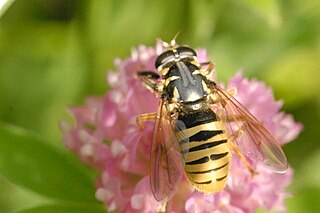
Temnostoma bombylans is a species of hoverfly. Larva of this species feed in decaying wood of deciduous trees.

Sphegina is a genus of small, slender hoverflies. They are widespread throughout Eurasia and North America. In flight they seem to have long hind legs which they often carry hanging down, making them resemble sphecid or ichneumonid wasps. Adult Sphegina are usually found in damp and shady habitats close to water in forested areas, and several species can often be found together. They often feed on white and yellow flowers of Apiaceae, Ranunculaceae, Asteraceae, and Rosaceae like Crataegus, Sorbus, and Sorbaria. Larvae nest in the sap of living and dead trees or in decaying cambium under tree bark lying in water or other damp conditions. The larvae of some species have been discovered in the tunnels of other xylophagous insects.

Temnostoma vespiforme is a species of hoverfly. Larva of this species feed in decaying wood of deciduous trees.

The Milesiini is a large and diverse tribe of hoverflies. They mimic wasps or hornets.

Sphecomyia is a genus of hoverfly in the family Syrphidae. There are about 16 described species in Sphecomyia.
Lejota aerea , the Golden Trunksitter , is an uncommon species of syrphid fly observed in eastern North America. Hoverflies can remain nearly motionless in flight. The adults are also known as flower flies for they are commonly found on flowers, from which they get both energy-giving nectar and protein-rich pollen. The larvae of this genus are found in decaying tree roots.
Lejota is a genus of syrphid flies in the family Syrphidae.
Chalcosyrphus japonicus is a species of hoverfly in the family Syrphidae.
Chalcosyrphus eugenei is a species of hoverfly in the family Syrphidae.
Sphecomyia tsherepanovi is a species of syrphid fly in the family Syrphidae.
Blerina is a subtribe of hoverfly in the family Syrphidae.
Lejota cyanea , the Cobalt Trunksitter, is an uncommon species of syrphid fly observed in the northeast and west coast of North America. Hoverflies can remain nearly motionless in flight. The adults are also known as flower flies for they are commonly found on flowers, from which they get both energy-giving nectar and protein-rich pollen. The larvae of this genus are found in decaying tree roots.
Lejota simplex is a species of syrphid fly in the family Syrphidae.
Lejota femoralis is a species of syrphid fly in the family Syrphidae.
Lejota villosa is a species of syrphid fly in the family Syrphidae.
Lejota korsakovi is a species of syrphid fly in the family Syrphidae.
Lejota ruficornis is a species of syrphid fly in the family Syrphidae.
Xylota atricoloris is a species of hoverfly in the family Syrphidae.
Xylota silvicola is a species of hoverfly in the family Syrphidae distributed in Russia.
Sphegina hodosa is a species of hoverfly in the family Syrphidae.




